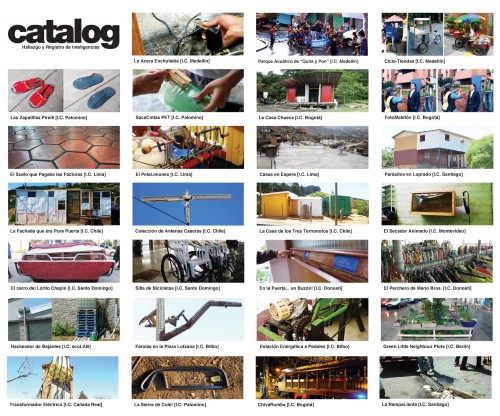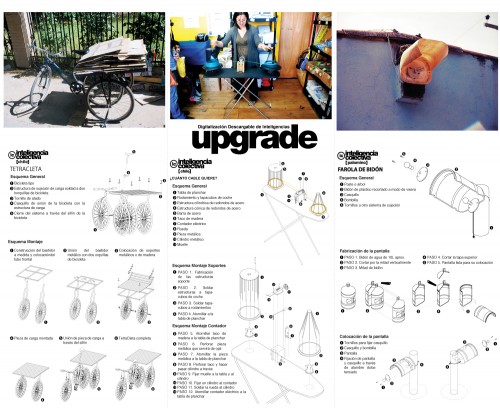Inteligencias Colectivas
http://www.inteligenciascolectivas.orgEvery region of the world has its own repertoire of construction techniques. The coexistence of different degrees of industrialization and development allows for the mixing of semi-industrial products with old and enduring techniques; however, they are only considered as valid in informal environments. While many of these construction solutions lack proper design planning, they generate a wide range of procedures through popular and generational wisdom. Few standardized products exhibit such great improvisation.
Inteligencias Colectivas draws its inspiration in part from this very ethos. Rooted in real-life examples of intelligent construction, this online platform and free database brings together knowledge considered to be on the fringe of traditional construction practice. This methodology is used in order to promote a type of technical know-how that is at once inclusive and public. A horizontal learning system—through tinkering with material prototypes—helps to weave together a tight network of people and collectives.
+ Few locations around the world still champion native construction techniques. While communal social structures have been lauded for their resourcefulness, low energy inputs and versatility, their assembling patterns are considered outside of the mainstream. As a result, the lived experience of makeshift culture has proved to be quite elusive.
+ This project is centered on architectural, planning and design techniques that combine conventional know-how with present-day needs. Many materials—re-usable, semi-industrialized, craft and manufactured—are incorporated into this study. While this initiative is geared mainly toward amateur builders, it aspires to something greater: to encourage and cultivate citizen science.
+ Even in developed countries, different levels of industrial and economic development have facilitated the merger of old craft techniques with semi-industrial products. The results can be seen in squatter settlements, for example, but these methods are often reviled and disappear once larger building “improvements” take place.
+ In “Northern” countries, the limited amount of opportunities for modifying the built environmment is especially prescient. Professional urban development fields are characterized by simplification and the loss of cultural relevance caused by a suite of factors: excesses of government control; the monopoly of trademarks and patents; the homogenization of neighborhoods; the deterioration of historic identity; and the strong division between architecture and the needs of its inhabitants.
+ In this globalized era, custom construction solutions need to be incorporated into the building proccess as a way to make longstanding social traditions and our ever-changing built environment commensurable.
+The Inteligencias Colectivas platform is developing this project in several ways:
Open online platform:
www.inteligenciascolectivas.org is an open-source database that contains construction techniques that blend craftsmanship and semiindustrialized products that happen to be from different regions of the world. Adaptive and iterative, this venture—by giving access to all citizens around the world—seeks to promote innovation and assemble the necessary tools to forge links among networks and between countries.
The platform includes different sections: “catalog”, where we can find basic documentation of existing intelligent solutions from different locations; “Upgrades” that includes graphical manuals where “intelligences” are analyzed and mapped, and “Prototyping”, that shows new constructions made by the platform that incorporate some of the previously found intelligences.
Prototyping:
Inteligencia Colectiva develops prototypes through workshops in collaboration with various organizations and agents in different locations. They serve as a tool that legitimizes this type of construction as it sets into different economic environments. The programmes they serve are discussed with future users (communities, institutions …): they go from solving basic needs in difficult life contexts to other requirements in public spaces and institutions.
Prototypes are designed and built involving “intelligent” authors that have been previously detected in each place: they serve as experts. Different intelligent solutions are incorporated into each design, from materials to construction methods or technology.
Methodology:
An active network of people is built by Inteligencia Colectiva. This network gets stronger through the design and construction of prototypes: working groups integrate neighboring institutions, professionals, artisans, builders, workshop participants and anonymous citizens.
In addition, many of the prototypes are the result of open educational workshops in collaboration with research institutes, universities or local entities. A horizontal methodology is developed in order to make all agents work coordinated but in absence of hierarchies. This allows every one (artisans, informal builders, teachers and students) to apprehend the capabilities of the others easily. We believe in horizontal hierarchy as an indispensable basis for the enhancement and learning of this type of technologies.
Urban approach
Inteligencia Colectiva works as a tool for developing a critical analysis of reality. These complex construction situations are usually surrounded by larger scale facts. Intelligences help us detect problems and opportunities that go from constructive details to urban strategies.
Regarding prototypes from an urban point of view, we find that even small size interventions refer to higher magnitudes, generating different typologies designed to suit each situation. It is a “street level” urbanism that works with inhabitants in a close relationship.
At a constructive level, as intelligences are incorporated into the prototypes, they refer to urban conditions: existing materials, techniques, resources and human capital are contextualized. We call it the “urbanism of collective intelligence.”





